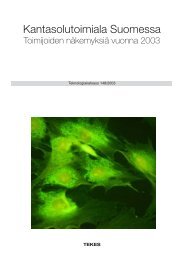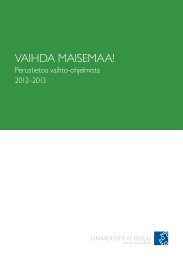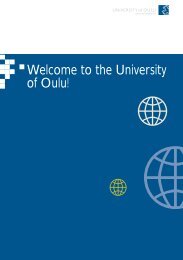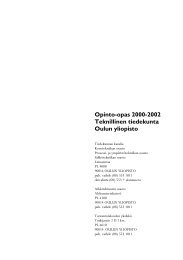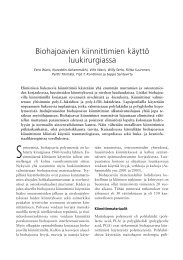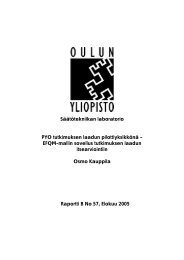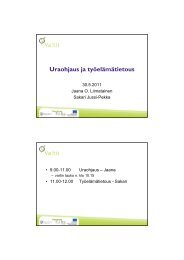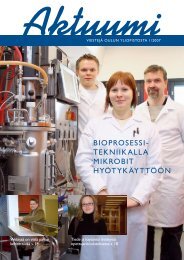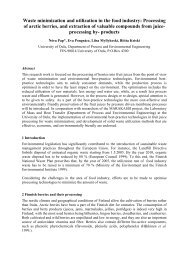A Study of Microcontrollers in Finnish Comprehensive Schools - Oulu
A Study of Microcontrollers in Finnish Comprehensive Schools - Oulu
A Study of Microcontrollers in Finnish Comprehensive Schools - Oulu
You also want an ePaper? Increase the reach of your titles
YUMPU automatically turns print PDFs into web optimized ePapers that Google loves.
Journal <strong>of</strong> Technology Education Vol. 18 No. 2, Spr<strong>in</strong>g 2007<br />
Figure 2. The project board be<strong>in</strong>g assembled<br />
(right).<br />
(left) and be<strong>in</strong>g tested<br />
<strong>Study</strong> Participants<br />
Twelve comprehensive (primary and secondary) school classes <strong>of</strong> grades 5-<br />
8 (ages 11-14 years) participated <strong>in</strong> the study. The number <strong>of</strong> children <strong>in</strong>volved<br />
was 230. The participat<strong>in</strong>g schools were located <strong>in</strong> <strong>Oulu</strong> Prov<strong>in</strong>ce: Järvikylä<br />
School <strong>in</strong> Nivala, Oksava and Mart<strong>in</strong>mäki <strong>Schools</strong> <strong>in</strong> Haapajärvi, Vattukylä,<br />
Hyttikallio and Karhukangas <strong>Schools</strong> <strong>in</strong> Haapavesi, Ruukki School <strong>in</strong> Ruukki,<br />
Kestilä Central School <strong>in</strong> Kestilä, Matkaniva and Petäjäskoski <strong>Schools</strong> <strong>in</strong><br />
Oula<strong>in</strong>en, L<strong>in</strong>tulampi School <strong>in</strong> <strong>Oulu</strong> and Kärsämäki Central School <strong>in</strong><br />
Kärsämäki. All the participat<strong>in</strong>g schools were state schools, which is the<br />
predom<strong>in</strong>ant comprehensive school system <strong>in</strong> F<strong>in</strong>land.<br />
Data collection<br />
True to the qualitative data collection methods, multiple data sources and<br />
strategies were employed, apply<strong>in</strong>g the concept <strong>of</strong> triangulation (Miles &<br />
Hubermann, 1994: 266). Data were collected <strong>in</strong> the follow<strong>in</strong>g ways: Pictures<br />
taken <strong>of</strong> the children work<strong>in</strong>g while mak<strong>in</strong>g the Picaxe applications, teacher’s<br />
written reports, researcher’s notes <strong>of</strong> the process and applications, children’s<br />
written and drawn sketches <strong>of</strong> their applications, photographs and video clips <strong>of</strong><br />
the children’s f<strong>in</strong>al outcomes, as well as <strong>in</strong>terviews <strong>of</strong> children documented on<br />
video record<strong>in</strong>gs. The <strong>in</strong>terviews were carried out <strong>in</strong> authentic situations where<br />
children expla<strong>in</strong>ed their applications. The questions asked from the children<br />
emerged spontaneously from the situation. Thus, the <strong>in</strong>terviews were not prestructured<br />
and, consequently, there was no “standard” time that they lasted<br />
either. Moreover, not every child was <strong>in</strong>terviewed. Some <strong>of</strong> the children’s<br />
applications called for more explanation than others. For example if the teacher<br />
told the researchers that not all the essential <strong>in</strong>formation <strong>of</strong> the child’s<br />
application were to be found <strong>in</strong> the sketches, draw<strong>in</strong>gs, etc., an <strong>in</strong>terview session<br />
was arranged to deepen the understand<strong>in</strong>g <strong>of</strong> what the child had actually done<br />
and accomplished.<br />
-40-



